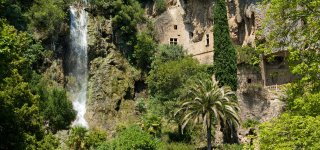Troglodyte village of Villecroze
Ranked "character village in the Var", the old village of Villecroze retains its medieval atmosphere and authenticity. Pedestrian, he loses the walker in a maze of streets connected by archways, arcades and squares.
The water streams upstream of the village was very early channeled to offer residents of supply points, seven fountains and freshen the village, fed by a large network of canals.
A former Magnanerie in the heart of the medieval village now houses a prestigious music academy, internationally renowned. Concerts are given in St. Victor Chapel Romanesque building from the 12th century with exceptional acoustics.
The silk was once home to an operation of sericulture, that is to say a silkworm breeding. The open-air theater at the foot of the medieval village surrounded by many mulberry trees in Provence: their leaves are the sole food of the silkworm, whose caterpillar is none other than the famous "silk worm".
The territory of Villecroze is of course famous for its caves, formed in the tuff cliff there are several hundreds of thousands of years. Long ownership of the Benedictine monks of the abbey of St. Victor Marseille, these caves were used for religious refuge during the attacks of the Saracens, common during the 10th century. A priory attached to the abbey was indeed present next to St. Victor Chapel in Villecroze. The fields surrounding the village were also the property of the religious community.
In the 16th century, a move dealings made caves of the hands of the Benedictine monks to those of Nicolas Albertas lord, who ruled the valley. The latter undertook to fortify the site to turn it into impregnable defense post. The caves, however, have never had to prove their effectiveness during any seat.
Never inhabited continuously, they are now owned by the town of Villecroze. They are classified as historical monuments, but also under natural sites in France: their interest is in double effect, while both geological and historical. tufa stone in which these caves were formed is from calcification and a fossilized plant of the cliff under the action of the cascade which watered there are 700 000 years.
Their visit gives see small natural ponds and sublime limestone concretions: stalactites, stalagmites and columns. In this natural wonderland, the human occupation is revealed through 5 levels furnished with loopholes, mullioned windows and protective bars.
If the caves are a must Villecroze, the village offers other places to walk and relax not to be missed. The city park is especially a haven of tranquility and greenery. Set in 1930 at the foot of cliffs and cave shelters, it extends over more than 2 hectares. Its terraced gardens, old orchards, give it a special charm. Wooded, city park Villecroze houses typically Mediterranean species like cedar, green oak, fig, Aleppo pine, laurel and magnolia. Its fairways are colored roses, wisteria and peonies. The park is crossed by a canal.
exceptional natural heritage of the territory of Villecroze, the waterfall participates to scenic site, including the city park. The water rushes down the cliff 35 meters high in the manner of an elegant veil, to continue its course through the channel and through the park. The source that feeds it is located on the territory of the hilltop village of Tourtour. It contributed by its richness in limestone, to the formation of the tuff cliff. The tour route of Villecroze caves to switch behind the waterfall. A watchtower hidden behind the veil of water offers an original view of the landscape.
